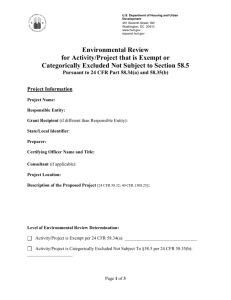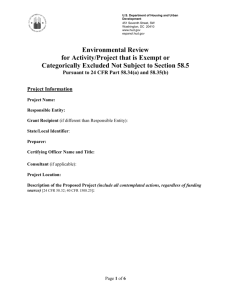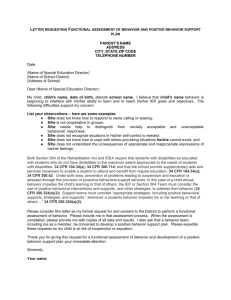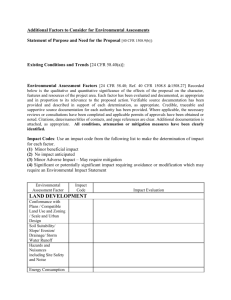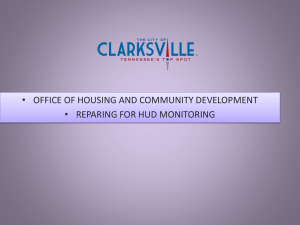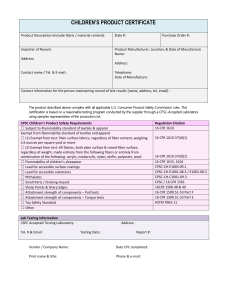Statutory Environmental Checklist
advertisement
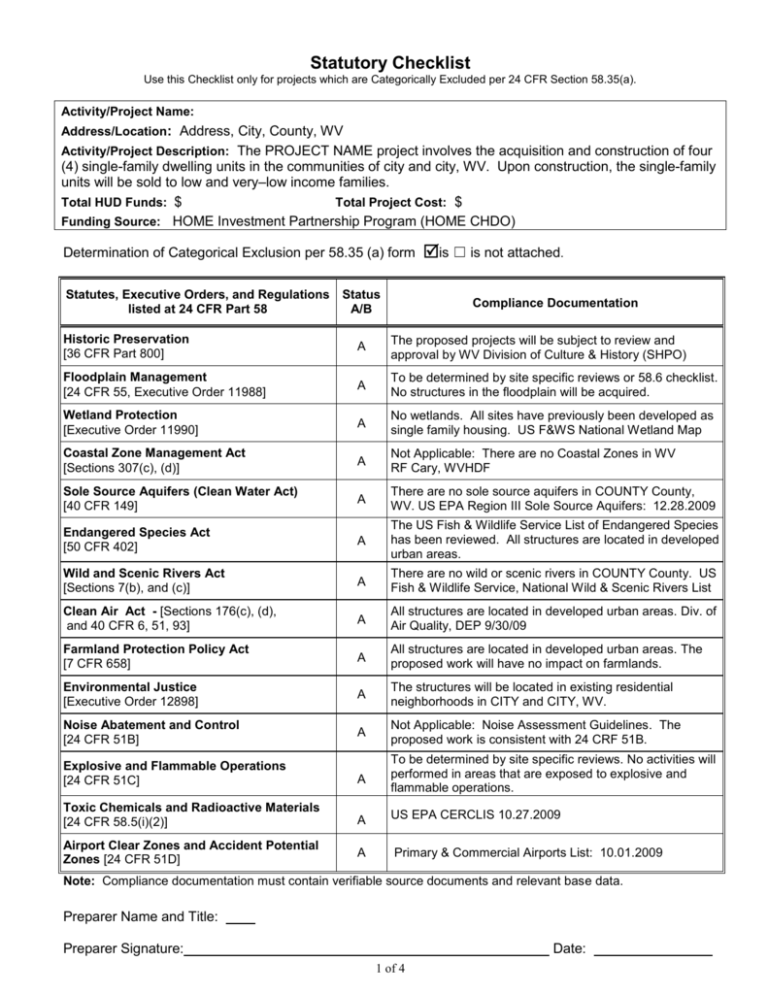
Statutory Checklist Use this Checklist only for projects which are Categorically Excluded per 24 CFR Section 58.35(a). Activity/Project Name: Address/Location: Address, City, County, WV Activity/Project Description: The PROJECT NAME project involves the acquisition and construction of four (4) single-family dwelling units in the communities of city and city, WV. Upon construction, the single-family units will be sold to low and very–low income families. Total HUD Funds: $ Total Project Cost: $ Funding Source: HOME Investment Partnership Program (HOME CHDO) Determination of Categorical Exclusion per 58.35 (a) form Statutes, Executive Orders, and Regulations listed at 24 CFR Part 58 Status A/B is ☐ is not attached. Compliance Documentation Historic Preservation [36 CFR Part 800] A The proposed projects will be subject to review and approval by WV Division of Culture & History (SHPO) Floodplain Management [24 CFR 55, Executive Order 11988] A To be determined by site specific reviews or 58.6 checklist. No structures in the floodplain will be acquired. Wetland Protection [Executive Order 11990] A No wetlands. All sites have previously been developed as single family housing. US F&WS National Wetland Map Coastal Zone Management Act [Sections 307(c), (d)] A Not Applicable: There are no Coastal Zones in WV RF Cary, WVHDF Sole Source Aquifers (Clean Water Act) [40 CFR 149] A There are no sole source aquifers in COUNTY County, WV. US EPA Region III Sole Source Aquifers: 12.28.2009 Endangered Species Act [50 CFR 402] A The US Fish & Wildlife Service List of Endangered Species has been reviewed. All structures are located in developed urban areas. Wild and Scenic Rivers Act [Sections 7(b), and (c)] A There are no wild or scenic rivers in COUNTY County. US Fish & Wildlife Service, National Wild & Scenic Rivers List Clean Air Act - [Sections 176(c), (d), and 40 CFR 6, 51, 93] A All structures are located in developed urban areas. Div. of Air Quality, DEP 9/30/09 Farmland Protection Policy Act [7 CFR 658] A All structures are located in developed urban areas. The proposed work will have no impact on farmlands. Environmental Justice [Executive Order 12898] A The structures will be located in existing residential neighborhoods in CITY and CITY, WV. Noise Abatement and Control [24 CFR 51B] A Not Applicable: Noise Assessment Guidelines. The proposed work is consistent with 24 CRF 51B. Explosive and Flammable Operations [24 CFR 51C] A To be determined by site specific reviews. No activities will performed in areas that are exposed to explosive and flammable operations. Toxic Chemicals and Radioactive Materials [24 CFR 58.5(i)(2)] A US EPA CERCLIS 10.27.2009 Airport Clear Zones and Accident Potential Zones [24 CFR 51D] A Primary & Commercial Airports List: 10.01.2009 Note: Compliance documentation must contain verifiable source documents and relevant base data. Preparer Name and Title: Preparer Signature: Date: 1 of 4 Statutory Checklist Use this Checklist only for projects which are Categorically Excluded per 24 CFR Section 58.35(a). DETERMINATION: This project converts to Exempt, per Section 58.34(a)(12), because it does not require any mitigation for compliance with any listed statutes or authorities, nor requires any formal permit or license (Status "A" has been determined in the status column for all authorities); This Exempt project may now be initiated; OR This project cannot convert to Exempt because one or more statutes/authorities require consultation or mitigation. Complete consultation/mitigation requirements, publish NOI/RROF and obtain Authority to Use Grant Funds (HUD 7015.16) per Section 58.70 and 58.71 before initiating the project; OR The unusual circumstances of this project may result in a significant environmental impact. This project requires preparation of an Environmental Assessment (EA). Prepare the EA according to 24 CFR Part 58 Subpart E. Preparer Name and Title: NAME, TITLE Preparer Signature: Responsible Entity Officer Name and Title: Date: September , 2010 Robert F. Cary, HOME Program Manager Responsible Entity Officer Signature: Date: September , 2010 2 of 4 Statutory Checklist Instructions For HUD funded projects that are categorically excluded per 24 CFR §58.35(a), the Responsible Entity (RE) must determine whether the proposal achieves compliance with each applicable statute, Executive Order or regulation with or without requiring formal consultation, mitigation, permits or having adverse effects on the resources protected by the statute. These instructions are a brief description of the essential findings needed to establish compliance. These instructions are not intended to replace the applicable regulations and applicable regulations take precedence. The Preparer of the Statutory Checklist must DOCUMENT OR ATTACH THE SOURCES OF THE DETERMINATION. Record the finding status on the STATUTORY CHECKLIST for each listed Federal statute, regulation, authority as follows: Status “A” applies when compliance with the authority is achieved without adverse effects on the protected resource, without necessary mitigation or attenuation AND when no formal consultation, permit or agreement is required to establish compliance. In these situations, enter “A” in the STATUTORY CHECKLIST status column. Status “B” applies when project compliance with the authority requires formal consultation, a permit or agreement, OR when the proposal may have an adverse effect on the protected resources. Part B summarizes what additional steps or formal procedures must be completed prior to submitting a Request for Release of Funds (RROF) to HUD or to the State. Evidence of completion and implementation of the required procedures or mitigation must be retained in the project Environmental Review Record (ERR). Historic Properties (including archeology): (A) The RE and SHPO agree that there are No Historic Properties Affected per 36 CFR 800.4(d)(1) and SHPO has not objected within 30 days to such fully documented determinations. (B) The proposal will have an affect on historic properties per §800.4(d)(2) This includes no adverse effect on historic properties §800.5. Consult with SHPO et al., per §800.5 et seq., to resolve or mitigate adverse effects. Floodplain Management: (A) The project does not involve property acquisition, management, construction or improvements within a 100 year floodplain (Zones A or V) identified by FEMA maps, and does not involve a “critical action” (e.g., emergency facilities, facility for mobility impaired persons, etc.) within a 500 year floodplain (Zone B). If FEMA has not published flood maps, the RE must make a finding based on best available data, e.g. from the City/County Engineer or local Flood Control Agency. (B) Complete the 8-step decision making process according to 24 CFR Part 55.20 to document that there are no practicable alternatives to the proposal and to mitigate effects of the project in a floodplain. Wetlands Protection: (A) The project does not involve new construction within or adjacent to wetlands, marshes, wet meadows, mud flats or natural ponds per field observation and maps issued by the U.S. Fish & Wildlife Service or U.S. Corps of Engineers. (B) Complete the 8-step decision making process in 24 CFR 55.20 to document there are no practicable alternatives and to mitigate effects of the project on wetlands. Such action also requires obtaining a permit from the U.S. Corps of Engineers under Section 404 of the Clean Water Act. Coastal Zone Management Act: (A) The project is not located in the coastal zone, or the project does not include new construction or major rehabilitation of existing structures, or the State Department of Ecology has accepted the RE’s certification that the project is consistent with the Coastal Zone Management Program. (B) Consult with the relevant State Department of Ecology to bring project into consistency with the CZMP. Sole Source Aquifers (Safe Drinking Water Act): (A) The project is not located within a U.S. EPA-designated sole source aquifer watershed area (including stream flow source areas), or the project need not be referred to EPA for evaluation according to an EPA approved MOU or checklist, or the EPA Ground Water Office has concurred that the project is “not likely to affect Sole Source Aquifer quality” in an informal consultation. (B) Consult with the Water Management Division of EPA to design mitigation measures to avoid contaminating the aquifer and implement appropriate mitigation measures. Endangered Species Act: (A) The RE determines that the proposal will have “no effect” or “is not likely to adversely affect” any federally protected (listed or proposed) Threatened or Endangered Species (i.e., plants or animals, fish, or invertebrates), nor adversely modify critical habitats. This finding is to be based on contact made with the U.S. Fish and Wildlife Service and NOAA Fisheries, or by special study completed by a professional biologist or botanist. Only a determination of “no effect” does not require being sent to U.S. FWS for concurrence. B) The proposal is “likely to adversely affect” any federally protected (listed or proposed) Threatened or Endangered Species. Consult with the U.S. FWS or with NOAA Fisheries, in accordance with procedural regulations contained in 50 CFR Part 402. Wild and Scenic Rivers Act: (A) The project is not located within one mile of a listed Wild and Scenic River, OR the project will have no effects on the natural, free flowing or scenic qualities of a river in the National Wild and Scenic Rivers system. (B) Consult with the U.S. Department of Interior, National Park Service for impact resolution and mitigation. 3 of 4 Statutory Checklist Instructions Air Quality (Clean Air Act): (A) The project is located within an “attainment” area, OR, if within a “non-attainment” area, conforms with the EPA-approved State Implementation Plan (SIP), per contact with a regional Clean Air Agency, AND the project requires no individual NESHAP permit or notification; (B) Negotiate suitable mitigation measures with the relevant regional Clean Air Agency, obtain necessary permits, issue required notices. (For example, 40 CFR §61.145 requires 10-day prior notification to the Air Quality District Administrator whenever either 260 linear ft., 160 sq.ft., or 35 cubic ft., of asbestos containing material is to be disturbed). Farmland Protection Policy Act: (A) The project site does not include prime or unique farmland, or other farmland of statewide or local importance as identified by the U.S. Department of Agriculture, Natural Resources Conservation Service NRCS (formerly the Soil Conservation Service), OR the project site includes prime or unique farmland, but is located in an area committed to urban uses; (B) Request evaluation of land type from the NRCS using Form AD-1006, and consider the resulting rating in deciding whether to approve the proposal, as well as mitigation measures (including measures to prevent adverse effects on adjacent farmlands). Environmental Justice: (A) The proposed site is suitable for its proposed use and will NOT have a disproportionate environmental impact on low income or minority populations; (B) Site suitability is a concern; the proposal is adversely affected by environmental conditions impacting low income or minority populations. Avoid such impacts or mitigate them to the extent practicable. Address and mitigate the disproportional human health or environmental effects adversely affecting the low income or minority populations OR reject the proposal Noise Abatement and Control: (A) The project does not involve development of noise sensitive uses, OR the project is not within 15 miles of a civil airport or military airfield, within 1000 feet of major highways or busy roads, or with 3000 feet of a railroad, OR ambient noise level is documented to be 65 LDN (CNEL) or less, based upon the HUD Noise Assessment Guidelines (NAG) for calculating noise levels and Airport Noise Contour map; (B) Apply the noise standard, per 24 CFR §51.101, to the decision whether to approve the proposal (see §51.104), and implement noise attenuation measures (NAG page 39-40) as applicable. Explosive or Flammable Operations: A) The project is located at an Acceptable Separation Distance (ASD) from any aboveground explosive or flammable fuels or chemicals containers according to “Siting of HUD-Assisted Projects Near Hazardous Facilities” (Appendices F & G, pp. 51-52), OR the project will expose neither people nor buildings to such hazards; (B) mitigate the blast overpressure or thermal radiation hazard with the construction of a barrier of adequate size and strength to protect the project (per 24 CFR 51.205). Toxic Chemicals and Radioactive Materials: (A) The subject and adjacent properties are free of hazardous materials, contamination, toxic chemicals, gasses and radioactive substances which could affect the health or safety of occupants or conflict with the intended use of the subject property. Particular attention should be given to nearby dumps, landfills, industrial sites and other operations with hazardous wastes. The environmental review of multifamily housing with five or more dwelling units (including leasing), or non-residential property, must include the evaluation of previous uses of the site or other evidence of contamination on or near the site, to ensure that the occupants of proposed sites are not adversely affected by any hazards. (B) Mitigate the adverse environmental condition by removing, stabilizing or encapsulating the toxic substances in accordance with the requirements of the appropriate Federal, state or local oversight agency; OR reject the proposal. Airport Clear Zones and Accident Potential Zones: (A) The project is not located within an FAA-designated civilian airport Runway Clear Zone (RCA) or Runway Protection Zone, or within the military Airfield Clear Zone (CZ) or Accident Potential Zone/Approach Protection Zone (APZ), based upon information from the airport or military airfield administrator identifying the boundaries of such zones, OR the project involves only minor rehabilitation, OR the project involves only the sale or purchase of an existing property in the RCZ or CZ; (B) It is HUD policy not to provide any development assistance, subsidy or insurance in RCZs or CZs unless the project will not be frequently used or occupied by people and the airport operator provides written assurances that there are no plans to purchase the project site. 4 of 4

